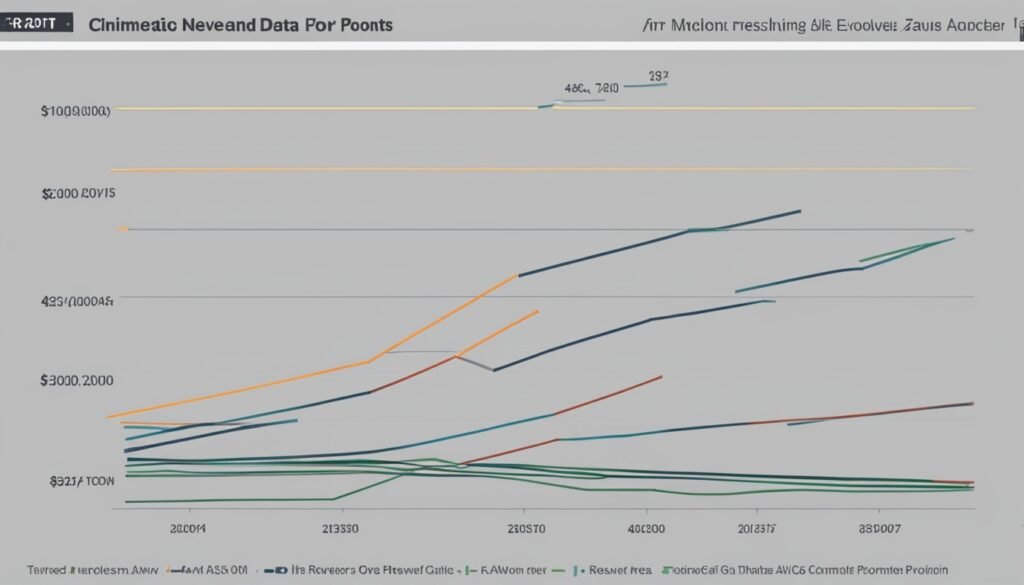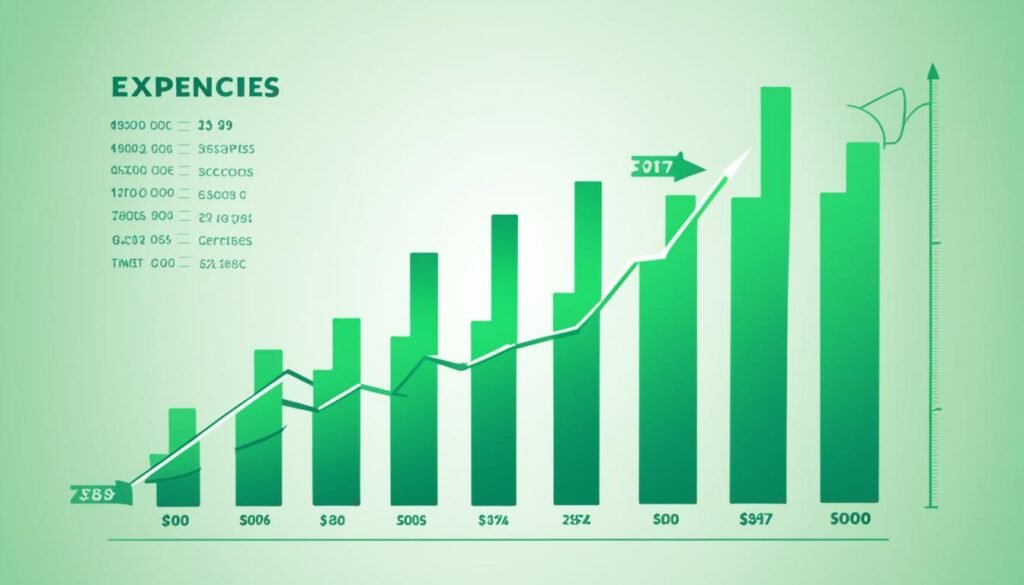When making your business plan, it’s key to list the main costs for starting and running your company. This includes things like salaries, rent, gas, insurance, marketing, and raw materials. Don’t forget about one-time costs like machinery, website design, and vehicles. Looking at how others in your industry spend can help guide your financial plans.
It’s also vital to make a sales forecast to guess your monthly earnings. By studying your market, you can make more realistic predictions. Using cash flow projections lets you show the money coming in and going out for the first year. You can also predict quarterly or yearly numbers for the second year.
To make good financial projections, think about using Excel spreadsheets or accounting software. Remember to use industry averages and your own past experiences to figure out when to count sales as cash. Your cash flow projections will help you make annual income statements and balance sheets.
Table of Contents
Understanding Financial Projections
What are Financial Projections?
Financial projections are key to any business plan. They help you predict your company’s future earnings and spending. By using past or estimated data, you can forecast how your business will do in the future. You can also see how changes in sales or costs might affect your profits.
It’s vital to know the difference between financial projections and financial forecasting. Forecasts look ahead for a short time, usually up to a year. Projections can cover both short and long-term, letting you explore different scenarios.
Financial projections are crucial for both new and established businesses. They’re key for business planning and drawing in investors. They show you understand your company’s finances and help you plan for future challenges or chances.
“The value of an enterprise is the present discounted value of its future cash flows,” (Harvard Business Review).
To make good financial projections, you need to collect data on your past and current finances. You also need to make smart guesses about your future. This means forecasting your income statement, balance sheet, and cash flow statement. This gives you a full picture of your business’s financial health and growth potential.

Creating detailed and researched financial projections helps your business succeed. It also makes it easier to get the funding and resources you need to reach your goals.
Importance of Financial Projections
Financial projections are key to business planning, financial decision making, and getting funding. They help you plan for the future, make smart choices, and keep an eye on your performance.
For startups, they help you set a budget, predict when you’ll make money, and track your financial goals. For businesses already up and running, they help set achievable targets and keep you on track financially.
When you’re looking for outside financing, like loans or investments, your financial projections are crucial. They show how your business could grow and how strong it is. This can help you get the funding you need to grow.
“Financial projections are the backbone of any successful business plan. They enable you to anticipate challenges, identify opportunities, and make informed decisions that drive your company’s growth.”
Understanding financial projections helps you use this tool well. It makes business planning easier, lets you make financial decisions with confidence, and sets your business up for success.

Gathering Data for Projections
To make accurate financial projections, you need to know your business and its industry well. Businesses can use their past financial data like balance sheets and income statements for strong projections. These records help predict future performance.
Startups or new ventures without a long financial history need to do a lot of research. They should look at market trends, customer behavior, and what competitors do. This helps them make smart guesses about their growth and performance.
- Use past financial statements to look at sales, expenses, and cash flow.
- Do deep market research to understand the industry, what customers like, and what competitors do.
- Look at industry benchmarks to see how your business could perform compared to others.
- Use methods like regression analysis to predict future trends from past data.
- Add insights from experts, market surveys, and your own knowledge to improve your projections.
Your financial projections should include cash flow, income statement, and balance sheet projections. These statements give a full picture of your business’s financial future. They help with making strategic decisions.

Financial projections are not fixed; they change as your business grows and the market changes. Keeping an eye on and updating your projections helps your business stay flexible and ready for growth.
Creating Financial Projections
Making accurate financial projections is key in business planning and financial forecasting. They show you the money side of your business goals. This helps you make smart choices to reach your goals.
First, figure out why you’re making these projections – for funding, planning, or checking how you’re doing. Then, pick a time frame that fits your needs, like monthly, every three months, or yearly.
- Estimate your expenses, like the cost of what you sell, running costs, regular bills, and one-time expenses. This shows how much money you’ll need to run your business.
- Guess your sales for each way you make money, thinking about what people want, your prices, and any changes you expect. This gives you a clear idea of your possible earnings.
- Add a 10-15% buffer to your expense guesses to cover unexpected costs and keep a safety net.
- Make a cash flow forecast to see how money moves in and out of your business. This is key for planning your finances.
- Put together an income statement to show your expected earnings and expenses. Also, create a balance sheet to display your net worth.
Remember, your financial projections will change over time. It’s important to keep an eye on them and adjust as needed. This keeps your financial modeling accurate and supports your goal setting efforts.
“Financial projections are not 100% accurate and tend to evolve over time, necessitating regular monitoring and documentation of results.”
With detailed financial projections, you can make smart choices, draw in investors, and set your business up for success over the long haul.

Financial Projections
Financial projections are key for checking how your business might grow, spotting risks, and getting money from investors or lenders. They let you see how different strategies could work for your business, like changing prices or getting more efficient.
These projections give you insights into your income, costs, profits, and financial duties. Knowing your financial outlook helps you make smart choices for your business’s growth. It also helps you understand risks and get the funding you need to do well.
Defining Financial Projections
Financial projections, as the American Institute of Certified Public Accountants (AICPA) says, show what might happen in the future based on certain assumptions. They are plans for what could happen, not what definitely will happen.
On the other hand, financial forecasts look at what will likely happen in the short term, usually yearly or quarterly. They use current and past data to show where your company stands financially. Forecasts are shared with people outside your company, like investors and lenders, to help them make decisions.
The Role of Financial Statements
Financial statements like income statements, balance sheets, and cash flow statements are very important for both forecasts and projections. They help you understand your business’s financial situation and make smart choices about its future.
When making financial projections, you look at things like where your business is located, how much money you’ll need, investments, labor needs, and past data. By considering these, you get a full picture of your business’s finances. This helps you make decisions that support its growth.
“Financial projections are key for checking your business’s growth potential, spotting risks, and getting funding. They give you insights into your income, costs, and profits. This helps you make smart decisions for your business’s success.”
Whether you’re working on forecasts or projections, these tools are vital for a strong business plan. By understanding and using financial projections, you can move forward with confidence. You can reduce risks and get the funding you need for your growth goals.
Monitoring and Adjusting Projections
Checking your financial performance often is key to your business’s success. By comparing your expected numbers with your actual results, you can see how you’re doing. This helps you spot areas that need changes. This way, you can make smart choices that improve your financial predictions and match your business goals.
If your expected numbers are too high or too low, it’s time to tweak them. Keeping your financial projections up-to-date helps them stay true to your business’s changing needs. This helps you adjust your strategy well, leading to better financial results and smarter decisions.
| Metric | Projected | Actual | Variance |
|---|---|---|---|
| Revenue Growth | 10% | 5% | -5% |
| Gross Profit Margin | 40% | 35% | -5% |
| Customer Acquisition Cost | $50 | $60 | +$10 |
| Return on Investment | 25% | 20% | -5% |
The table shows why it’s important to watch key performance indicators (KPIs) and adjust your financial forecasts. By keeping an eye on metrics like revenue growth, gross profit margin, customer acquisition cost, and return on investment, you can see where your forecasts were off. This lets you make smart changes to your strategy and improve your forecasting.
It’s crucial to keep an eye on and adjust your financial forecasts for your business’s long-term success. By being alert and adapting to changes in your finances, you can fine-tune your business strategy. This leads to steady growth and profits.
Tools and Resources
Creating and managing financial projections is key for your business planning. Use tools like spreadsheets, accounting software, or financial templates to make it easier. These tools help you make important financial documents like cash flow statements and balance sheets. They also ensure your financial modeling is accurate and consistent.
Microsoft Excel is a top choice for financial modeling because it’s easy to use and has lots of features. It also has many formulas and functions. Besides, tools like Cube and Jirav offer advanced forecasting and help with financial planning and analysis.
When picking financial modeling tools, look for an easy interface and lots of customization. Make sure they work well with other systems, let you work with others, show data in a clear way, and have good reporting. Also, choose tools that keep your financial data safe and reliable. Using these tools and resources can make your financial projections easier and help you make smart business decisions.




13 Comments on “How to Create Financial Projections for Your Business Plan 2024”